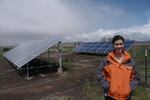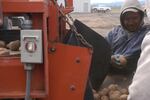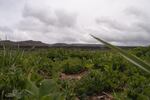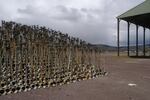
A field ready for planting in the Klamath basin
Amelia Templeton
MALIN, Ore. -- Solar power has made inroads on off-the-grid dairies trying to shrink their carbon footprints and on sprawling ranches where it’s easier to put up a panel than to connect to the grid. But in the Northwest, most of these projects generate very little energy.
Walker Brothers potato farm, in Oregon's Klamath Basin, is trying out solar power on a whole new scale.
It’s a spring day on the farm. Farm Manager Lexi Crawford walks along a flowing irrigation canal. In a few weeks, sprinklers will spread this water over a new crop of potato plants. Red-winged blackbirds sit in cattails along the canal. One bird spots a better perch. Crawford watches as it lands on long stretch of solar panels.
“This panel set here will help with powering this irrigation pump," she says.
Walker Brothers farms is a conventional operation that sells about half its potato crop to Frito Lay. Crawford has been filling out the paperwork for five new sets of solar panels. She says they're preparing to put panels up on the roofs of several huge potato storage sheds. And they've installed two sets of solar panels at the edges of fields-- just outside the path of the farm's moving pivot irrigators.
This farm uses electric power to maintain water pressure in many of its irrigation pumps and sprinkler systems. The farm’s potato storage and packing sheds also need electric power. It adds up to more than you might guess.
“We looked at numbers from 2009 and our power bills were about $200,000 for the year,” Crawford says.
A big machine rumbles as it runs seed potatoes along a belt so workers can sort and size them before they are planted. Daniel Jepson helps monitor the quality of the potato crop on this farm. He says potatoes need a lot of irrigation. And they need to be treated gently and kept cool after they come out of the ground. All that takes electricity, he says.
"It’s an intensive crop," Jepson says. "For example, when we put them in the cellars we have to supply fresh air continually, otherwise they’ll actually use up the oxygen in those piles and literally suffocate. The cells begin to die and you'll have a potato that has a black heart.”
When the farm’s solar panels aren’t powering pumps or cooling potatoes, they feed energy back onto the grid. And that shows up as a credit on the farm's utility bill. Not only that, but Walker Brothers won a coveted allocation from Oregon's "feed-in tariff" program, with help from the solar installation company, RS Solar. Through the state program, the farm gets paid a high rate for the solar energy they feed into the grid. And they pay a lower rate for the electricity they take from it.
Tricia Hill, a member of the Walker family and a partner in the business, says her dad has spent years researching solar power options for the farm.
“His desire to install solar panels comes from that wanting to drive down cost, wanting to be on the cutting edge," Hill says. "We have a lot of sunshine days in Klamath County so it makes sense as something to look at to control costs.”
Walker Brothers expects its credit from solar power to offset up to 40 percent of its utility bill. That may not sound like much, but this project is about 100 times larger than the average on-farm solar project in the Northwest. About 600 farms in Oregon, Washington, and Idaho have installed solar panels. But not many of them use solar power to cut down their electricity bills. Instead, they’re using small arrays to generate power in remote places. Picture a pump that draws water for cattle out on the range -- like the one Gary Wright installed on a remote part of his Klamath Basin ranch.
“Every day I was traveling, three or four miles on a back road to run a generator," Wright says. "So I looked into the investment of solar.”
Wright ranches cattle and grows alfalfa about ten miles down the road from Walker Brothers potato farm. He says small solar pump has saved him labor and created a little oasis.
“It's direct sunlight and when the sun shines it pumps. It’s actually for wildlife also. We have chukars and deer and antelope that use it," he says.
The water on these farms and ranches comes from the Klamath River system. Wright used to be able to use as much as he needed. His power was cheap too, thanks to a fifty-year contract. Times have changed. Threatened salmon need cool, clear water flowing in the Klamath River in the summer, so in dry years less water is available to irrigate these farms. Power is more expensive, too. As these changes happened, Wright drilled a lot of wells and he considered using solar power to pump all his water.
“I couldn’t afford the investment." He says. "It was over $3 million.”
Wright thinks it could be a good investment. But he’s not sure he’ll be around long enough to see it pay off.
“That’s a young man’s venture. and I don’t think I want to step into a 3 million dollar investment whether I have some grants or not to go with it," he says.
Wright may have dropped the idea of a solar powered ranch. But other farmers in the Klamath Basin have asked for federal funding to help bring more renewable energy projects here.






